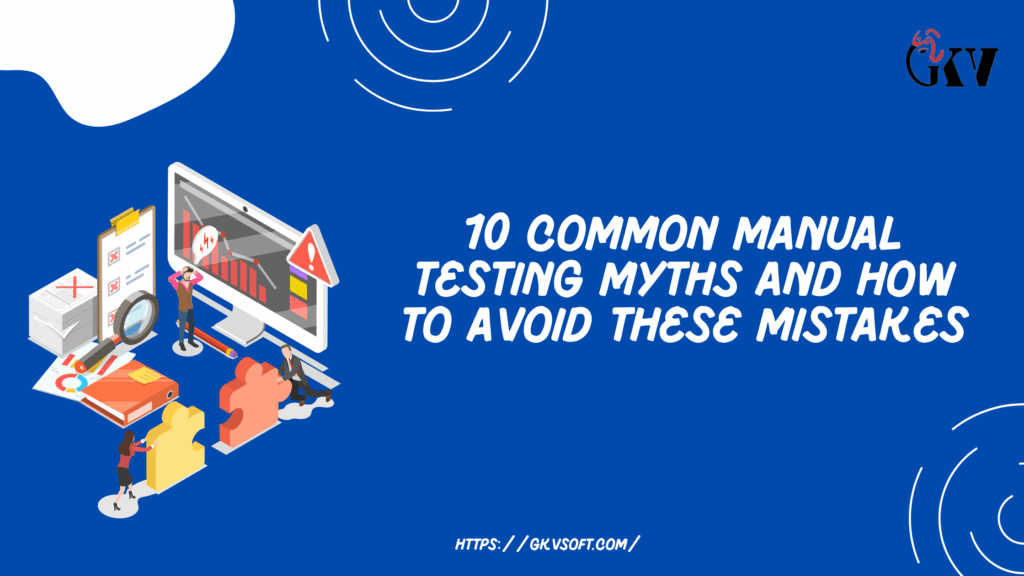With the dawn of automated frameworks, one can’t ignore the importance of manual testing even in today’s fast-paced software development lifecycle. In fact, the importance of manual testing is as significant as ever when it comes to quality assurance. Even seasoned quality assurance guys tend to get caught in these traps that sap the effectiveness of the testing process. This is why an attempt has been made to document the 10 common pitfalls of manual testing as well as provide 5 insightful steps to improve one’s testing approach.
10 Common Manual Testing Myths
Inadequate Test Planning
Planning, in particular, has proven to be a big issue for most testers. Lots of testers do not plan ahead of time and jump straight to execution. This results in test scenarios being missed, resources not being used effectively, and change requests not being catered to. Quite often, this will lead to critical defects being discovered much later, sometimes even after the system has been put into production.
Missing Requirements
This has always been a tricky issue when it comes to executing test cases, as it requires a full understanding of the application. Not having an understanding of the application’s requirements leads to incorrect test cases, testcase creation, and leads to serious oversights. Testers validation functionalities using incorrect expectations which unwittingly grant a lot of false confidence in what is considered “good” quality.
Poor Test Data Management:
Test data which is inadequate unlocks hidden edge cases and key real-world problems. If comprehensive test data is not available for various scenarios, the testers tend to lose out on chances of identifying critical bugs that only seem to appear under specific conditions.
Neglecting Cross-Platform Testing:
Ignoring the compatibility of different devices or browsers constitutes an oversight in the quality evaluation of the system. Users today can access and use applications from different platforms, therefore cross-device and cross-browser testing is critical in today’s application environment.
Vague Defect Reporting:
Defect reporting is always accompanied by reproducing the documents. Cutting out steps to reproduce a bug will waste development’s time and always end up having ‘cannot reproduce’ as an outcome. If the documented defects have blank areas, there will be unnecessary conflict within development teams, thus slowing down resolving issues.
Skipping Regression Testing:
Quality gaps occur when new features are added without ensuring that previous features function as intended. Due to the complexity of the application, one might not realize all the interconnected components that could be impacted during a change. Hence regression testing becomes imperative, considering the myriad possibilities of functional interdependencies.
Inconsistent Test Execution:
Reliability is diminished by heuristic methods of test execution, leading to uncompleted defects and questions around consistent reproducibility. When procedures are not established or users fail to follow guidelines, testing loses reliability as a pass/fail gate and becomes chaotic.
Overlooking User Experience:
Considering usability and user experience issues are often overlooked by most testers concentrating on functionality. A correctly working application from a technical aspect can still be hard for any user to operate if it does not meet user expectations in terms of flow and intuitiveness.
Unstable Test Environments:
Inadequate setup of environments leads to duplication of effort in discovering non-existent defects. Non-existent issues in the production environment are the result due to incorrect setup of the test environment. Issues pertaining to environment setup can either hide real defects or can create the illusion of facing an issue where, in reality, there isn’t any.
Poor Communication with Developers:
Operating in silos with no direct access to the development team leads to gaps in achieving quality and timely fixing of identified defects. Testers and developers working in silos miss out on synergies that could help both the teams to enhance the quality of the product.
How GKV Software Solutions Avoids Mistakes During Manual Testing
About GKV Software Solutions
GKV Software Solutions is one of the preeminent providers of quality assurance services offering end-to-end testing solutions for businesses of all sizes. GKV is able to help organizations through the software development lifecycle with innovative testing strategies, modern tool sets, and experienced methodologies because of their certified testing professionals and years of industry experience. Their client-driven custom solutions enhance operational efficiency, reduces expenses, and guarantees superior user satisfaction across web, mobile and enterprise applications.
5 Strategies to Avoid Testing Mistakes
- Structured Testing Framework
GKV has developed testing frameworks that capture the unique requirements of each client with standardized test planning, execution, and reporting on all levels. Our methodologies standardize documentation alongside developed checklists which, for customizing, ensure critical testing elements are not missed.
- Requirements-Driven Testing Approach
The certified testing professionals work closely with all relevant stakeholders to gain complete clarity of the requirements before the test case design begins. GKV’s requirements traceability matrix guarantees that all functionality is tested thoroughly against the business reality.
- Cross-Functional Collaboration Model
The integrated GKV testing teams interact routinely with system developers, business analysts, and other relevant stakeholders, working through established channels and contacts. This collaboration removes the silo mentality ensuring all aspects and views are incorporated per each phase of the testing life cycle.
- Real-World Test Data Strategy
Our approach to test data management is exhaustive, addressing boundary conditions, edge cases, and negative scenarios based on actual user interactions. GKV maintains rich data sets that go beyond standard computation to automated testing which helps reveal defects that would otherwise be overlooked.
- Quality-Focused Testing Culture
GKV Soft offers complete software testing solutions, tailored to both industry standards and custom client expectations, and they ensure all manual and automated tests are carried out accurately on our clients’ systems. We make it a point to train all of our QA specialists to evaluate applications from the end-user perspective to guarantee not just functional accuracy, but also to ensure that user satisfaction is at the core of our services.
Conclusion:
Understanding these strategic approaches to testing helps QA teams become the perfect perfectionists they are meant to be, and aids in delivering a sublime product on the proverbial plate. One must remember that successful Manual Testing encompasses far more than bug detection —providing insightful analysis that enhances user experiences and building dependable applications is key.

